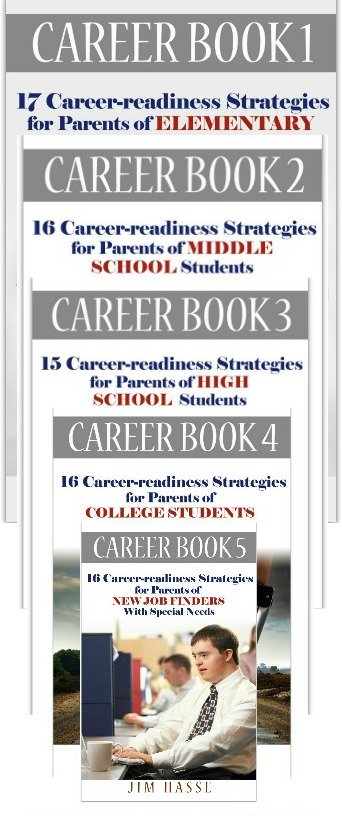Goal Setting for Kids: Cerebral Palsy Career Builder for Elementary Students
By Jim Hasse, ABC, GCDF, Disability Employment Expert
_________________________________________________________
Goal setting for kids is practicing that skill and setting an example as a career-coaching parent of your elementary student with cerebral palsy (CP) so he or she can become familiar with the process.
I remember passing notes between my mom and my third grade teach on a regular basis. Just that pre-cell phone, pre-Internet means of communication in 1953 told me that both were working for my welfare and I’d better “toe the line” (whatever that meant in terms of homework, behaving in class, not being so weepy etc.).
That’s how I believe goal setting for kids starts. Your youngster recognizes your dedication to his or her well-being simply by observing your day-to-day activities which are the result of the goal setting you’ve done, either in your head or on the keyboard.
High expectations and praise
I noticed those notes each Monday and Friday in 1953 as I made the trek between our home farm and my orthopedic school often yielded some form of praise from my mom or from my teacher.
As you engage in goal setting for youngster, find reasons to praise your youngster every day. By doing so, you’re reinforcing his or her talents and strengths. That shows your youngster that you believe he or she is a valuable and capable individual who will live a meaningful life as an adult.
Goal setting for kids involves having high expectations for learning and behavior, both at home and at school. When you expect the best from your youngster, he or she will rise to your expectations.
As a “guest” in the homes of the four “house parents’ I had between second and eighth grade, I knew what mom expected: that I behave and be polite during the week in my dealings with the mom and dad of the family and their kids in my Madison “home.”
It was my responsibility because I was basically functioning without her supervision for five days out of every week. So, I automatically knew what goal setting for kids was all about by the time I was eight.
 Photo courtesy of mamiverse.com
Photo courtesy of mamiverse.comExamples of goal setting for kids
Make sure your youngster is getting the best education possible by working directly with your school and its teachers. How do you do that? Here are some goal-setting tips for kids from state of Oregon's Partnership for Occupational and Career Information:
Talk with your youngster’s teachers
- Introduce yourself at the beginning of the school year.
- Attend parent-teacher conferences.
- Arrange a time to observe the teaching in your youngster’s classroom, if possible.
- Find out if your youngster’s teacher uses e-mail to communicate with parents.
- Send the teacher a thank you note when you notice your youngster has learned a new skill.
Talk with your youngster about his or her schoolwork
- Ask about homework and check to see that your youngster has done all the work assigned.
- Ask your youngster to show you his or her schoolwork and note comments made by the teacher.
- Ask to see papers sent home by the school.
- Discuss how the skills your youngster is learning in school are an important part of everyday life.
- Let your youngster see you reading, writing, and using math.
Help your youngster develop routines
- Have regular homework or reading time.
- Make sure your youngster has a regular bedtime that allows for plenty of rest.
- Give your youngster age-appropriate chores.
- Make sure your youngster has a nutritious breakfast before school.
Teach your youngster to love to read
- Read to your youngster from an early age.
- Let your youngster see you read.
- Listen to your youngster read.
- Limit TV viewing and video games.
- Take your youngster to the library to check out books of interest to him or her.
- Provide your youngster with books and magazines written at his or her reading level.
Create a study environment in your home
- Do not allow the TV to be on while your youngster is doing homework.
- Make a "study area" that has paper, pencils, pens, erasers, a dictionary and other materials your youngster uses to do schoolwork.
- Stay nearby when your youngster is doing homework in case your help is needed.
- Check your youngster’s homework when finished.
Spend time with your youngster at home
- Ask your youngster about his or her day.
- If you have multiple children, try to spend one-on-one time with each child.
- Use car time to talk with, and listen to, your children.
- Take walks or ride bikes together.
- Look for things to do as a family such as having a “movie” or “game” night.
- Eat dinner together, using the time to talk about the day’s events.
Goal setting for kids doesn’t have to be difficult or complicated. Each of the suggestions I listed above can be one of your goals for career coaching your elementary school youngster with CP.
Return from Goal Setting for Kids to Job Titles
Go to Cerebral Palsy Career Builders
This is Creative Commons content. You can freely and legally use, share and repurpose it for non-commercial purposes only, provided you attach this sentence and the following attribution to it (including the two links):
Originally written and illustrated by Jim Hasse, ABC, GCDF, owner of Hasse Communication Counseling, LLC, who, as a person with cerebral palsy, served for 10 years as a vice president in a Fortune 500 company during his 29-year career in corporate communication. He’s an Accredited Business Communicator, certified as a Global Career Development Facilitator and author of 14 Amazon books about disability awareness and disability employment issues.





